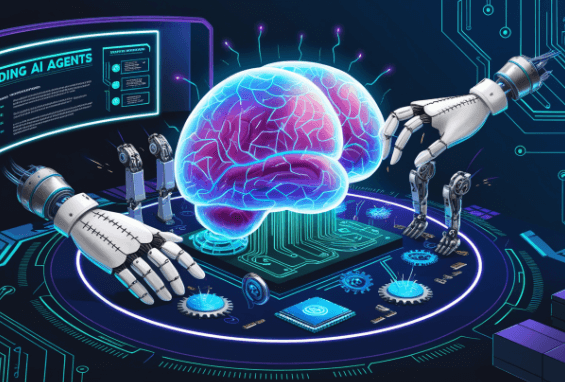Generative AI Architecture: Building Blocks, Models, and Practical Insights

Introduction to Generative AI
In recent years, generative AI has emerged as a groundbreaking field within artificial intelligence, enabling machines to create new content that closely resembles human-generated data. This technology is not only reshaping industries but also challenging our understanding of creativity and originality. As generative AI continues to evolve, understanding its architecture and underlying principles becomes increasingly crucial for developers, researchers, and businesses seeking to harness its potential.
What is Generative AI?
Generative AI refers to a class of algorithms that can generate new data instances similar to existing datasets. Unlike traditional AI, which primarily focuses on recognizing patterns and making predictions based on input data, generative AI can create original content, such as images, text, music, and even video. Key examples include deepfakes, AI-generated art, and natural language processing applications like chatbots. The field relies heavily on various neural network architectures to produce high-quality outputs that are often indistinguishable from real-world data.
See also: Immigration Solicitors in Manchester: Expert Legal Guidance at Primus Solicitors
The Core of Generative AI Architecture
● Foundation Models and Pre-trained Architectures
Foundation models are large-scale, pre-trained models designed to understand and generate human-like text and images. These models serve as the backbone of many generative AI applications. By pre-training on diverse datasets, they capture a wide range of knowledge and language patterns, allowing for fine-tuning to specific tasks. Notable examples include GPT (Generative Pre-trained Transformer) for text and DALL-E for images.
● Neural Networks in Generative AI
Neural networks, particularly deep learning models, play a pivotal role in generative AI. They enable the learning of complex patterns and representations within data. In generative tasks, neural networks can be used to synthesize new data points by learning from the features of the input data. Key types of neural networks used in generative AI include Convolutional Neural Networks (CNNs) for image generation and Recurrent Neural Networks (RNNs) for sequence data like text and audio.
Key Differences Between Generative AI and Traditional AI
| Aspect | Generative AI | Traditional AI |
| Purpose | Create new content | Analyze and predict existing data |
| Output | New data instances | Classifications, predictions |
| Model Types | GANs, VAEs, Transformers | Decision trees, SVMs, linear regression |
| Data Dependency | Requires diverse datasets for training | Often trained on labeled datasets |
Building Blocks of Generative AI Models
Generative AI models are built using several key components, each playing a vital role in the creation process.
● Transformers and Attention Mechanisms
Transformers, introduced in the seminal paper “Attention is All You Need,” have revolutionized natural language processing and generative tasks. They rely on attention mechanisms to weigh the importance of different input data elements, allowing the model to focus on relevant parts of the input when generating output.
● The Role of Self-Attention
Self-attention is a critical mechanism within transformers that enables the model to relate different parts of the input data to one another. By assigning varying attention scores to different tokens, the model can capture contextual relationships, which is essential for generating coherent and contextually appropriate content.
● Sequence-to-Sequence Models
Sequence-to-sequence (seq2seq) models are a type of neural network architecture that transforms input sequences into output sequences. These models are widely used in applications like language translation and text summarization, where the input and output are both sequences of varying lengths.
● Bidirectional Encoder Representations
Bidirectional Encoder Representations from Transformers (BERT) allow models to understand context from both directions (left and right). This bidirectional approach enhances the model’s ability to grasp nuances in language, making it particularly useful for tasks like sentiment analysis and question answering.
Key Generative AI Models
Generative AI encompasses various models, each with unique features and applications.
● GANs (Generative Adversarial Networks)
GANs consist of two neural networks—a generator and a discriminator—that work against each other in a game-like setting. The generator creates new data instances, while the discriminator evaluates their authenticity. Through this adversarial process, GANs can produce highly realistic images, videos, and other data types.
● VAEs (Variational Autoencoders)
Variational Autoencoders (VAEs) are a type of generative model that learns to encode input data into a latent space and then decode it back to the original data. VAEs are particularly effective for tasks like image generation and anomaly detection, as they can sample from the learned latent space to produce new instances.
● Diffusion Models and Their Importance
Diffusion models are a newer class of generative models that create data by iteratively refining random noise. They are gaining attention for their ability to generate high-quality images and other data formats. These models work by simulating a diffusion process, gradually transforming noise into coherent data.
Training Generative AI Models
The success of generative AI models hinges on effective training strategies.
● Data Preparation and Preprocessing
Data preparation is a crucial step in training generative models. This process involves cleaning, normalizing, and augmenting the dataset to ensure it is representative of the target domain. Proper preprocessing enhances the model’s ability to generalize and produce high-quality outputs.
● Model Training and Fine-Tuning
Training generative AI models typically involves unsupervised or semi-supervised learning. Fine-tuning pre-trained models on specific datasets helps adapt their capabilities to particular tasks, improving performance and output quality. This phase often requires significant computational resources and careful monitoring to avoid overfitting.
Applications of Generative AI
Generative AI is transforming various sectors by enabling innovative applications.
● Content Creation in Media and Art
In the creative industries, generative AI is revolutionizing how content is produced. Artists and designers are using AI to create unique artworks, music compositions, and even video games. Tools like OpenAI’s DALL-E allow users to generate images from text descriptions, blurring the lines between human and machine creativity.
● AI-Powered Design and Prototyping
Generative design algorithms help engineers and designers explore a vast array of design possibilities. By setting specific parameters, these algorithms can generate optimal designs, leading to more efficient and innovative products.
● Healthcare Advancements
In healthcare, generative AI is making strides in drug discovery, medical imaging, and personalized medicine. By generating molecular structures or simulating patient data, AI can accelerate research and improve patient outcomes.
Challenges in Generative AI Development
Despite its potential, generative AI faces several challenges.
● Ethical and Bias Considerations
Generative AI systems can inadvertently reinforce biases present in their training data, leading to ethical concerns. Addressing these biases is critical to ensuring fair and equitable AI applications.
● Computational and Resource Constraints
Training generative models require substantial computational power and resources. High costs associated with cloud computing and specialized hardware can hinder accessibility for smaller organizations and researchers.
Future of Generative AI and Emerging Trends
The future of generative AI is promising, with several emerging trends shaping its evolution. These include advancements in multimodal models that integrate different data types, improved training techniques to reduce bias, and more efficient algorithms that lower computational requirements. As technology evolves, generative AI is likely to play a central role in various industries, driving innovation and creativity.
How Moon Technolabs Can Help With Generative AI Solutions
Moon Technolabs is at the forefront of AI development, offering expert solutions tailored to your business needs. Our team specializes in building and deploying generative AI models that enhance creativity, efficiency, and productivity. By leveraging cutting-edge technologies and methodologies, we help businesses harness the full potential of generative AI, whether for content creation, design, or data analysis.
Conclusion
Generative AI represents a transformative force in the realm of artificial intelligence, with its architecture and models continuously evolving. Understanding the building blocks, training processes, and applications of generative AI is essential for leveraging its capabilities effectively. As we move forward, collaboration between businesses and AI experts like Moon Technolabs will be crucial in navigating the challenges and opportunities presented by this innovative technology. With the right strategies and insights, generative AI has the potential to reshape industries and drive creative advancements, paving the way for a more innovative future.





